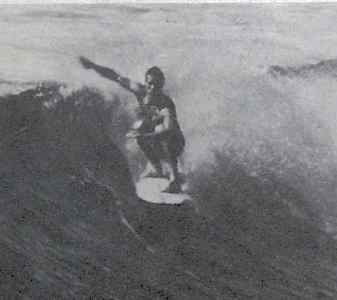surfresearch.com.au
 |
surfresearch.com.au
history
: foam
|
foam, 1960
Gordon 'Grubby'
Clarke in a letter detailing the closure of his Californian
plant, December 2006...
Hobie Alter and Dave Sweet
independently showed that a polyurethane foam surfboard was
possible. Rodger Jennings, Chuck Foss, and Harold Walker
pioneered the first successful commercial blank business
selling blanks directly to surfboard builders. A lot of
other people were involved including myself. All of the
resins, supplies, processes, and equipment were very
original innovations.
Upon founding Clark Foam I begin using
different foam formulations, processing methods, and
equipment than the other blank manufacturers. Today my plant
is almost all original designs, built in-house by our staff
and myself. The small amount of equipment purchased outside
of Clark Foam was built to my specifications or modified by
me for our unique process. To sum this up no one in the
United States or for that matter the rest of the world uses
equipment and a process like mine. It is very unique and
there was nothing on earth ever built this way before.
Early foam experiments, 1957
The first Australian manufactured
balsa/fibreglass boards, three only, were by Rodger 'Duck'
Keiran soon after the Olymic Carnivals, but a lack of balsa wood
supply meant that the design was not available for general use.
- Bob McTavish : Pods for Primates Part 1
in Tracks Magazine,1972.
The impact of the US Malibu boards was
severe to encourage builders to experiment with a variety of
alternative manufacturing techniques.
Possibly based on a Popular Mechanics
article published in 1953 detailing the constuction of a Styrofoam
Surfboard, several used a combination of polystyrene foam
and expoxy resin.
McDonagh at Freshwater (Greg McDonaugh in Pollard,
page 56) and Scott Dillon with Noel Ward at Bondi used
polystyrene foam that was commerically available for insulation.
In a shed in Wellington Lane, Bondi, Dillon
and Ward glued foam blocks together, timber without stringers,
and shaped the board with a course rasp ("Surform").
The boards were glassed initially with
epoxy resin and 16 oz woven rovings, then coated with a 5 oz
cloth film.
The variation in colour and texture of the
glassed board required a coat of paint to finish the board.
South Bondi Board Club member, 'Bluey
Mayes', ordered a board with a large gold M painted on the nose.
- Scott Dillon
Interview 29th June 2005. Coffs Harbour NSW.
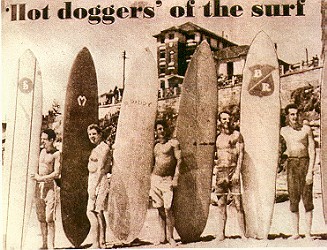
Malibus and Pigs, Bondi 1958
One noted alternative,
possibly dating from this period was a board constructed of two
fireglass molds, joined at the rail with an adhesive black
plastic bead.
The board was filled with a course matted
substance for floatation and featured a fin box.
The noted example was green on the bottom
with a white deck.
"Embracing
modern
technology, the lighter, shorter, and more manouvrable
American malibu surf board gained popularity after
lifeguards from Hawaii and California demonstrated its
capabilities at Torquay in 1956 (136).
According to Cronulla's Bill Eady
and Gus Staunton, the hedonistic 'free spirit' of board
riders was at odds with the core humanitarian role of
disciplined surf lifesavers, which was to protect surf
bathers from the perils of the sea.
Consequently there was animosity
between board riders and surf lifesavers on Cronulla
Beach.
Apart from philosophical
differences, the danger of of surfboard riders crashing
into surf bathers was immense.
Therefore, as the protectors of
Cronulla Beach it fell to lifesavers to enforce Sutherland
Council regulations (137), such as in 1957 containing
board riders to a section of North Cronulla Beach
known as 'the alley' (138)."
1960
By 1960 most builders were producing a
stable, if not perfect, polyester blanks.
Some manufacturers resorted to using a
'swelling box' to allow the blanks to stabilize before shaping.
The standard Malibu was a foam/fibreglass
laminate with a redwood stringer, 9 ft –10 ft 6”.
Extra features could include multiple
stringers, tail blocks, and pigment colours.
Fins were either fibreglassed timber
or solid fibgreglass.
Common fin shapes were the Standard D,
Square or Reverse D (or Phil or Pixie.)
Some builders continued to use balsa, for
example Wally Caryle, though
mostly this was reserved for Gun boards.
Noted examples were built by Les Patterson
at Scott Dillon Surfboards & later at Dale Surfboards.
- Bob McTavish : Pods for Primates Part 1
in Tracks Magazine,1972.
Sport Magazine for Nov 1960 article
"Why Surf Clubs Are In Trouble" discussing the increasing
popularity of board riding.
Prone craft continued to be made in various
designs, most home builders continuing to use plywood.
Professional manufactures quickly produced
Belly and Kneeboard in balsa wood and then foam.
See Paipo Catalogue, 1960 - 1964.
Bondi, 1960.
"I was a Bondi boy, imported from
Canada in 1960.
Joined the South Bondi Boardriders
Club, surfed with some of the 'legends' Bluey Mays, John
'Wheels' Williams (of Manly),
Johnny O'Donovan, old Vic Hogan, Noel
Ward, Billy Bushel, of course the young gremmies,
Kevin Brennen etc.
Other members of SBBC included Jim
Robinson, Mick McKelvey, Andy 'Cucuracha' Cochrane, Dennis
Colette, Johnny Nobel, and Rick DeRuiter.
I have a picture of a wave at Nielson
Park circa 1961.
An other event Bondi boys were
involved in was being on the television game show the
'Dating Game.'
Bluey Mayes girlfriend, Brenda
Backhouse was probably, if not the first woman surfer in the
Eastern suburbs.
Kerry Yates was the local "Gidget" and
ended up with the Sydney Daily Telegraph writing weekly
surfing articles.
One of her articles about Bob McTavish
stowing away to Hawaii resulted in him getting caught and
deported back to Aussie."
- Mike Bennett (formerly the "Canadian
Kook", South Bondi Board Riders Club, circa 1960) of Scottsdale,
Arizona, emailed these notes in June 2011 (edited).
Brenda Backhouse.
In 1917, the most consistently noted female
surfboard rider at Bondi Beach was Kathelene Musgrave.
See Source Documents
1917-1918 The Surf.
Extracts from the first surfing newspaper,
twenty weekly issues between December 1917 and April 1918.
Kerry Yates.
Also wrote a series of articles in the early
1960s for the Australian Womens' Weely.
See Source Documents
1960 Australian Womens' Weely : Surfing.
Extracts from 1961, 1963, 1964 and 1966.
"Yates, Kerry
An Australian journalist whose meeting
with Paul benefited her career.
Glenn A Baker relates the event in his
book The Beatles
Down Under.
"Kerry was seventeen years old and
working for Women's Weekly when the Beatles arrived in
Sydney in June 1964. She was among the large group of
reporters and photographers waiting in a corridor in the
Sheraton hotel, hoping to get a story on Paul as he was
celebrating his 22nd birthday.
Paul decided to have a few words with
the press, but as soon as he saw Kerry he went straight to
her and invited her to his room for an interview.
Kerry commented, 'I had long blonde
hair and a pink sweater and I must have stood out from all
the grey and brown suits because Paul made a beeline right
for me and invited me up to his room. He let my photographer
take shots of him surrounded by his presents and the next
week we ran one of them on the front cover with my
"exclusive" story inside. For years I've been asked what I
had to do to get that scoop, which really did help my
career. I know that everyone wants to know but I'm not
saying if I did it or if I didn't.' "
- Bill Harry: The Paul McCartney
Encyclopedia, July 2011.
http://www.wingspan.ru/bookseng/encyclopedia/y.html
South Coast, 1960.
"Was in the first group with Bluey to
surf Green Island, down south.
Also, the Bondi boys were among the
first visitors to the far south coast and even down to
Bells.
The first groups that went to
Ulladulla were around 1960, refer to Ivan Johnson's history
of the Mollymook SLSC, bottom of page 32."
- Mike Bennett, email June 2011 (edited).
"At the start of the season a visit to the area by members
of the South Bondi Boardriders Club [many of whom were members
of the Bondi SLSC], was to have ramifications to the local
area.
Some members of the Mollymook SLSC had at the end of 1960,
locally pioneered surf board riding, using malibus.
They had been able to combine both surfing and surf
lifesaving without any problems.
Bob Evans, Ian Hunter, Bob Davidson, Peter Williams and Ivan
Johnson were the first, and many of the younger club members
over the next few seasons followed on.
The visit of the surfers' from other areas like Bondi on
'surfaris' seeking out new, unspoiled waves, introduced the
youth to a new culture that did not include surf lifesaving in
the equation.
Basically it meant a competition in coastal areas for the
pool of local youth which has continued on ever since."
Image, Page 31: "The first
boardriders. From left Ivan Johnson, Bob Evans, Ian Hunter"
Board portraits, two Pig boards and one
Malibu, outside old Mollymook clubhouse..
Image, Page 32: "Bob Cairns, club
member posing in his 'neck to knee' costume."
Balsa Pig board portrait outside old
Mollymook clubhouse.
- Johnson: Mollymook SLCS
(2010) pages 31-32.
Ivan Johnson noted that his first board was
bought from Bill Clymer from Sydney by a local who used it
briefly before onselling to Ivan.
- noted in phone conversation, July 2011.
Many thanks to Ivan.
Western
Herald,
Bourke,
Friday 4 November 1960, page
12.
SURFBOARDS
TO BE
LICENSED
Surfboard riders using beaches throughout the Syd ney metropolitan area this year will have to pay a 5/- registration fee.
Seaside councils have agreed to do this in an effort to control riders causing accidents among swimmers.
Licensing the boards will en able surf
club members and Council rangers to identify board
owners who cause trouble.
The officials have the power under the new regula tions to confiscate boards.
The registration will take the form of a sticker attached to the centre of the board 12 inches from the nose.
Manly Council beach supervisor, Mr. R. Brewster, said the regulations.would help reduce the number of accidents which occur each year between swimmers and board riders.
He said seaside Councils had adopted a common method: of marking areas reserved for surf
riders.
This would; enable anyone going to different beaches to know exactly where they could ride boards.
Surf
club members are exempt from the license fee which lasts 12 months.
Trove
1960 'SURFBOARDS TO BE
LICENSED.', Western Herald (Bourke, NSW : 1887 - 1970), 4
November, p. 12, viewed 1 September, 2013,
http://nla.gov.au/nla.news-article103982536
1961 Offset or Hook Tails by
Midget Farrelly via Bob Cooper & Renyolds Yater(US) 10 ft
Pollard
page 26
1961
Formation of Dee Why Surfing
Fraternity, DY, NSW.
Peter Palmer
noted in August, 2007
Dear Geoff,
Not sure if it is of note for you but Dee
Why Surfing Fraternity is currently updating its archives.
As you may know DYSF is Australia's
oldest Board riders club. Established in 1961 we have never
stopped charging which we think may well make us the longest
continuous running club in the world as many have come and
gone and occasionally been resurrected but to our knowledge
no other club has been going that long. Sorry to all who
thought otherwise but we were around before Surfing Australia
- in fact Midget was our first President a couple of years
prior to being inaugural president of Surfing Australia..
We can count old champions
and current and recent WCT and WQS names as members and you'll
note there is a Documentary DVD to be released in a few weeks
( September 1, 2007)
our website is at :
dysf.info
There is a history page detailing the
earliest days. More is to come
And if you check out our "Members"
page you'll see a link to details regarding the DVD " Why Dee
Why" ....And No, as far as I know , no proceeds from the
DVD are going to the club! damn..
I kinda think we're part of Australian
Surfing History.
best regards and keep up what I'm sure is
at times the onerous but always worthwhile work.
peter palmer
some old guy who's trying to help with
the dysf site.
1961, June 6
Dave Jackman rides Queenscliff Bombora,
which makes the front page of a Sydney newspaper.
His board is currently held by Barry Bennett
Surfboards, Brookvale.
In a subsequent article Dave Jackman
credited Claude West, and others, with first riding the break
and notes
... I paddled my board out while
Claude says he made his approach from a surf boat.
Pollard
page 100.
The board is shown on the video cover of Nat
Young's The History of Australian Surfing.
1962
Foley boards, very short sub 8 ft,
have a short lived popularity in Sydney.
In 1962 Foley boards had a bit of
interest.
A 6 ' 6" wide tail board, another
foreshadow.
- McTavish : Pods for Primates Part 1,
Tracks Magazine,1972.
Named after a US surfer, Jim Foley,
who was photographed riding a short board in the second edition
of Surfer magazine.
- McTavish: Stoked! (2009), page
125.
McTavish's 1963 stowaway companion, Dave
Chidley, is filmed riding a short (Foley) board with Mick Dooley
at Currumbin in Dennis Elton's Follow the Surf
(1963).
See Thoms: Surfmovies (2000),
page 86.
John Smythe (aged 13) of Manly, purchased
his six foot Gordon Woods ‘Foley’ board in 1962.
He recalled:
Gordon Woods made mine and another
friend's 6ft 6? board and Scotty Dillon made one for another
friend.
John Otton had a small board made for
him around 1960- it was marble painted.
Dave Treloar had the (6 foot?) Hobie
his brother bought him in the states c1961. S
o there was, around 1962-63, a small
number of (Sydney) grommets riding short boards.
- edited from notes and photographs posted
by Gary Crockett on the Surf City Blog, June 20th, 2011
at 1:10 pm
http://blogs.hht.net.au/surfcity/
Many thanks to Garry and John.
The development of foam boards in the US,
circa 1957-1958, is usually credited to Hobie Alter and/or Dave
Sweet.
See http://www.davesweetsurfboards.com/SweetHistory.htm
In Australia, most larger manufacturers were
continuing to struggle with blowing their own blanks.
By investing time and effort into blank
blowing technology, and securing significant cost reduction by
placing large orders, Barry Bennett
established an independent foam company (Polytron Foam?) that
came to market dominance.
Mike Hickey
Mike emailed in Junr 2010 (edited):
It's a long way and a long time from 1962 , when Deborah Kerr
and her husband Peter Viertel , who had introduced surfing in
France from California, had met with me in London and persuaded
me to join them in Bairittz for the contests.
I had just arrived from Peru, before that, Hawaii .
Peter knew me from the February edition of Surfer International
which had announced Pipeline as the new surfing spot because it
had just been ridden (outer Pipe) by 2 Americans (Greg Noll
and Ricky Grigg) and 2 Australians (Hickey and Bob Pike)
of which I was the one who took the biggest wipe-out.
That wipe-out on a 32 foot face made a great photo published in
the centre of the magazine .
I was so ashamed to see that photo.
Now I am proud of it , and what we pioneered.
Nat Young: History (1983) page 94.
Two Australian surfers, Bob Pike and Mike
Hickey, happened to be in Hawaii one winter and with a host of
Californians and Hawaiians were invited to compete in the
first surfing contest in Peru.
After the contest Bob returned to
Australia but Mike, who had met two French surfers in Peru and
had heard about the waves of Biarritz, on the French coast,
went off to Europe.
The next thing everyone knew Mike Hickey
had become the first European surfing champion.
http://southsiders-mc.blogspot.com/2009/01/origin-of-surf-in-europe-part-1.html
In September (1958) a team of Australian
Lifesavers comes to Biarritz and rescue demonstrations. The team
came without planks swell and is non-existent for the duration
of their stay except the last day when the Australians like Mike
Hall, show what they can do: start drifting forward, up to two
on a plate The premises ... turns discover that surfing is not
to do than the wave length.
www.surfersvillage
Surf History
(rough translation from French)
A tribute to Peter Viertel, one through whom
surfing arrived in France
Surfersvillage Global Surf News ,
7 May, 2008: - - Monday, May 12, all surfers
are invited to return for a tribute to Peter Viertel, who by
that surfing has arrived in France. Meet at 11am on the beach
Parlementia (Bidart / Guéthary) with your board.
Peter Viertel with a known history of the
board arrived in Hollywood and surfed for the first time in
September 1956 Hennebutte Côte des Basques, died this winter,
shortly after the disappearance of his wife, Deborah Kerr
actress and patron of the first French surf club, Waikiki.
In his will, Peter Viertel has
requested that some of his ashes were thrown into the sea
initiative of his family and friends, Joel and Stella de Rosnay,
a rally will therefore take place May 12 to Parlementia rather
that the Basque Coast for reasons of logistical convenience.
As is the
tradition of surfing, surfers in the water will form a large
circle in which children Viertel will board a boat to carry out
the will of the deceased.
With high tide at 11:38
and 56 coef forecasts tiny swell up, the conditions are right
for one to be very many in this tribute to a man whose
friendship and loyalty have done (and still are) the Roots of
French surfing spirit.
Let the surf in honoring
him.
SPORT
MAGAZINE 1962 FEBRUARY- Surf Lifesaving Crisis
Waikiki
Surf Club
Presents
9th Annual International
Surfing
Championships
January 6,7 and 13-14, 1962
75c.
Makaha Beach, (Waimea?) Ohau
|
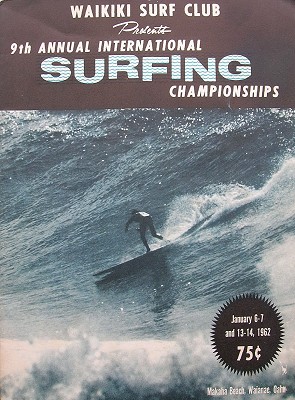
|
Page 6
1962 INTERNATIONAL
SURFING CHAMPIONSHIPS
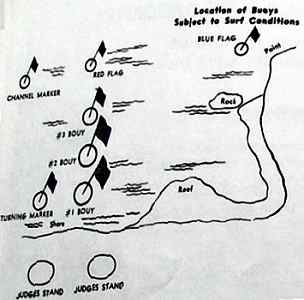
|
Point
System for Length of Rides
(5 to 30) per Wave
BLUE FLAG (point surf) to any part
RED FLAG (big blow hole) to any part
FLAG #3 (line of blow hole)
FLAG #2 (blow hole)
FLAG #1 (inside regular blow hole) |
of channel
to shore
to bowl
of channel
to shore
to shore
to shore
to shore |
20 points
30 points
10 points
10 points
20 points
15 points
10 points
5 points |
Point
System for Performance (1 to 10) per Wave
1. General riding ability
and versatility.
2. Judgement.
3. Sportsmanship
Note: When there is more than one numbered buoy, 5 points will
be given for buoy that is passed standing.
Two or more points will be deducted each time a contestant
goes to his knees or prone position while attempting to
complete the ride.
Contestants will be allowed to catch as many waves as possible
in the time allowed, the best 3 or more rides will be used to
determine the winner.
All contestants must go outside all the buoys when returning
out, unless they are to catch a wave at the location that they
turn at.
If position is changed due to a bigger set, caution must be
used not to interfere with the incoming surfers.
Page 7
Makaha
International Champions
1953
Only flat water events were held dure to the poor surf conditions.
1954
George Downing
1955
Rabbit Kekai
1956
Conrad Canha
1957
Jamma Kekai
1958
Peter Cole
1959
Wally Froiseth
1960
Richard Keaulana
|
Women
Not scheduled
Ethel Kuke
Ethel Kukeu
Vicky Heldreich
Marge Calhoun
Linda Benson
Wendy Cameron |
Junior
Alan Gomes
Alan Gomes
J. Raydon
Timmy Guard
Joseph Napoleon
Paul Strauch Jr.
Eric Romanchek |
Tandem
Walt Hoffman and Jean Jones
Ed Whaley and Nancy Boyd
Robert Krewson and Kehau Kea
Not held
Rabbit Kekai and Heidi Stevens
Ed Whaley and Diana Moore
Ernest Werner and Robin
Grigg |
Back
Cover: Advertisement
We are proud to announce that at the I960 Makaha
International Surfing Contest, "Hobie
Surfboards" placed 1st in Junior Men's and Women's
surfing and 2nd and 3rd in Men's and Tandem surfing.
We feel this is a tribute to our surfboards.
Every "Hobie Surfboard" is manufactured in our shop
under our own quality control from start to finish.
This fact, combined with our unequalled experience in
the field of surfboard manufacturing and retailing makes
us the best equipped to handle the most difficult custom
orders.
We carry a large inventory of new boards for the
customer's convenience allowing for quick delivery on
custom orders.
We invite you to come in and see our latest models
featuring the greatest variety of shapes, colors and
laminated strip designs.
HOBIE
SPECIALIZING
IN SATISFIED CUSTOMERS
Whether
It Be Beginner or Expert
34195
Coast Highway, Dept. M. Dana Point, Calif., Gypsy
6-5222
NOW
AT THE FOLLOWING LOCATIONS
WAIK1KI
BEACH CENTER
2425 Kalakaua
Ave. Phone 936463
OAHU CHARTER FISHING
CENTER
1061 Ala Moans
Blvd. Phone 503330
HAWAII WATER SPORTS
Sand Island
Road Phone 814444
|
HOBIE ALTER
MANUFACTURER
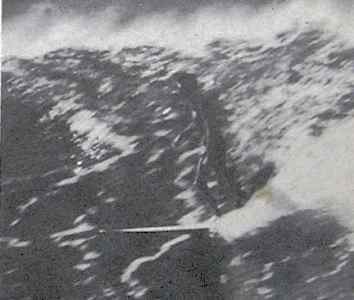
GEORGE DOWNING
DISTRIBUTOR
|
1961-1962 Makaha International Championship,
Hawaii.(February 12th)
1st George Dowling (H)
Women - Anona Naome (H)
:

surfresearch.com.au
Geoff
Cater (1999-2016) : History: 1959
http://www.surfresearch.com.au/1959.html
REFERENCES FOR THIS SECTION
books
1959 Bloomfield,
John Know-how in the Surf
Angus and Robertson 89 Castlereagh
Street, Sydney
1961 Harris, Reg. S.The
History of Manly Life Saving Club 1911-1961
Published by Manly Life Saving Club,
NSW Printed by Publicity Press Ltd.
1966 Finney, Ben and
Houston, James D. : Surfing – A History of the Ancient
Hawaiian Sport
Pomegranate Books P.O. Box 6099
Rohnert Park, CA 94927 Reprint 1996
1968 Kahanamoku, Duke With
Brennan, Joe: Duke Kahanamoku’s World of Surfing
Angus and Robertson Publishers Sydney
, Australia 1972 2nd Edition A&R Paperbacks, Sydney ,
Australia
1970 Margan, Frank and
Finney, Ben R. : A Pictorial History of Surfing
Paul Hamlyn Pty Ltd, 176 South Creek
Road, Dee Why West, NSW 2099.
1964 Pollard, Jack
(ed.): The Australian Surfrider
K.G.Murray Publishing Co.P/L,142
Clarence Street , Sydney Australia
1972 The Best of
Tracks (Vol. I) Editors : Falzon, Albert;
Stewart, John; Grissim, John. :
Tracks Publishing Co Pty Ltd. P.O.
Box 178 Avalon, NSW.
'Bob McTavish’s Personal History of
Surfboard Design – Pods for Primates Parts 1' (pages 120 – 122).
1992 Stell, Marion K.
: Pam Burridge
Collins Angus & Robertson
Publishers (Australia) Pty. Limited
A division of Harper Collins
Publishers (Australia) Pty. Limited
25 Ryde Road, Pymble NSW 2073,
Australia
1997 Warshaw, Matt : Surfriders
–
In Search of the Perfect Wave
Tehabi Books, Inc. Collins
Publishers, 10 East 53rd Street, New York, NY 10022
1978 Warwick, Wayne A
Guide to Surfriding in New Zealand Second Edition
Viking Sevenseas Ltd Wellington, New
Zealand
1979 Young, Nat ;
Photographs by McCausland, Bill: Nat Young’s Book of Surfing
A.H. & A.W. Reed Pty. Ltd. 53
Myroora Rd, Terry Hills, Sydney.
1983 Young, Nat with
McGregor, Craig : The History 0f Surfing
Palm Beach Press,40 Palm Beach Road,
Palm Beach NSW 2108
film
1985 A History of
Australian Surfing Nat Young.
magazines
1971 Modern World
July Shane Steadman/Terry Fiztgerald (possibly) :
'Surfboard Design' pages 30 to 36.
1972 Surfing World.
Volume 16 #4. Bob Evans : 'remember the time when...'
pages 30 to 35.
web sites
Malcom Gault-Williams: LEGENDARY SURFERS Homepage

surfresearch.com.au
Geoff Cater (2000-2016) : History : Foam,
1960.
http://www.surfresearch.com.au/1959_Foam.html






